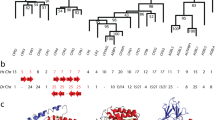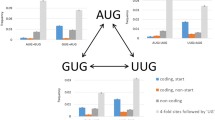Abstract
Multiple genes of the hoatzin encoding stomach lysozyme c and closely related members of this calcium-binding lysozyme c group were cloned from a genomic DNA library and sequenced. There are a minimum of five genes represented among these sequences that encode two distinct groups of protein sequences. One group of three genes corresponds to the stomach lysozyme amino acid sequences, and the remaining genes encode predicted proteins that are more basic in character and share several sequence identities with the pigeon egg-white lysozyme rather than with the hoatzin stomach lysozymes. Despite these structural similarities between some of the hoatzin gene products and the pigeon lysozyme, phylogenetic analyses indicate that all of the hoatzin sequences are closely related to one another. This is borne out by the relatively small genetic distances even in the intronic regions, which are not subject to the selective pressures operating on the coding regions of the stomach lysozymes. These results suggest that multiple gene duplication events have occurred during the evolution of hoatzin lysozymes.
Similar content being viewed by others
References
Avise JC, Nelson WS, Sibley CG (1994) Why one-kilobase sequences from mitochondrial DNA fail to solve the hoatzin phylogenetic enigma. Mol Phylo Evol 3:175–184
Dautigny A, Prager EM, Pham-Dinh D, Jollès J, Pakdel F, Grinde B, Jollès P (1991) cDNA and amino acid sequences of rainbow trout (Oncorhynchus mykiss) lysozymes and their implications for the evolution of lysozyme and lactalbumin. J Mol Evol 32:187–198
Dobson DE, Prager EM, Wilson AC (1984) Stomach lysozymes of ruminants. I. Distribution and catalytic properties. J Biol Chem 259:11607–11616
Gilbert W (1978) Why genes in pieces? Nature 271:501
Grajal A, Strahl SD, Parra R, Dominguez MG, Neher A (1989) Foregut fermentation in the hoatzin, a neotropical leaf-eating bird. Science 245:1236–1238
Haldane JBS (1932) The causes of evolution. Harper & Row, New York
Hedges SB, Simmons MD, van Dijk MAM, Caspers G-J, de Jong WW, Sibley CG (1995) Phylogenetic relationships of the hoatzin, an enigmatic South American bird. Proc Natl Acad Sci USA 92: 11662–11665
Irwin DM (1995) Evolution of the bovine lysozyme gene family: changes in gene expression and reversion of function. J Mol Evol 41:299–312
Irwin DM, Sidow A, White RT, Wilson AC (1989) Multiple genes for ruminant lysozymes. In: Smith-Gill SJ, Sercarz EE (eds) The immune response to structurally defined proteins: the lysozyme model. Adenine Press, Schenectady, NY, pp 73–85
Irwin DM, Prager EM, Wilson AC (1992) Evolutionary genetics of ruminant lysozymes. Anim Genet 23:193–202
Irwin DM, White RT, Wilson AC (1993) Characterization of the cow stomach lysozyme genes: repetitive DNA and concerted evolution. J Mol Evol 37:355–366
Irwin DM, Yu M, Wen Y (1996) Isolation and characterization of vertebrate lysozyme genes. In: Jolles P (ed) Lysozymes: model enzymes in biochemistry and biology. Birkhäuser Verlag, Basel, pp 225–242
Irwin DM, Wilson AC (1989) Multiple cDNA sequences and the evolution of bovine stomach lysozyme. J Biol Chem 264:11387–11393
Irwin DM, Wilson AC (1990) Concerted evolution of ruminant stomach lysozymes. Characterization of lysozyme cDNA clones from sheep and deer. J Biol Chem 265:4944–4952
Jung A, Sippel AE, Grez M, Schütz G (1980) Exons encode functional and structural units of chicken lysozyme. Proc Natl Acad Sci USA 77:5759–5763
Kimura M (1983) The neutral theory of molecular evolution. Cambridge University Press, Cambridge
Kornegay JR (1994) Evolution of avian lysozymes. PhD thesis, University of California, Berkeley
Komegay JR, Schilling JW, Wilson AC (1994) Molecular adaptation of a leaf-eating bird: stomach lysozyme of the hoatzin. Mol Biol Evol 11:921–928
Li W-H, Graut D (1991) Fundamentals of molecular evolution. Sinauer, Sunderland, MA
Li W-H, Tanimura M, Sharp PM (1987) An evaluation of the molecular clock hypothesis using mammalian DNA sequences. J Mol Evol 25:330–342
Maddison WP, Maddison DR (1992) MacClade: analysis of phylogeny and character evolution, version 3.0. Sinauer, Sunderland, MA
Miller AH (1953) A fossil hoatzin from the Miocene of Colombia. Auk 70:484–489
Ohno S (1970) Evolution by gene duplication. Springer-Verlag, Berlin
Olson SL (1985) The fossil record of birds. Avian Biol 8:79–238
Pahud J-J, Widmer F (1982) Calf rennet lysozyme. Biochem J 201: 661–664
Prager EM (1996) Adaptive evolution of lysozyme: changes in amino acid sequence, regulation of expression, and gene number. In: Jollès P (ed) Lysozymes: model enzymes in biochemistry and biology. Birkhäuser Verlag, Basel, pp 323–346
Prager EM, Jollès, P (1996) Animal lysozymesc andg: an overview. In: Jolles P (ed) Lysozymes: model enzymes in biochemistry and biology. Birkhäuser Verlag, Basel, pp 9–31
Sambrook J, Fritsch EF, Maniatis T (1989) Molecular cloning: a laboratory manual, 2nd ed. Cold Spring Harbor Laboratory Press, Cold Spring Harbor, NY
Satta Y, O'hUigin C, Takahata N, Klein J (1993) The synonymous substitution rate of the major histocompatibility complex loci in primates. Proc Natl Acad Sci USA 90:7480–7484
Sibley CG, Ahlquist JE (1990) Phylogeny and classification of birds. A study in molecular evolution. Yale University Press, New Haven, CT
Stewart C-B, Schilling JW, Wilson AC (1987) Adaptive evolution in the stomach lysozymes of foregut fermenters. Nature 330:401–404
Swanson KW, Irwin DM, Wilson AC (1991) Stomach lysozyme gene of the langur monkey: tests for convergence and positive selection. J Mol Evol 33:418–425
Swofford DL (1993) PAUP: phylogenetic analysis using parsimony, version 3.1.l. Illinois, Natural History Survey, Champaign, IL
Wilson AC, Ochman H, Prager EM (1987) Molecular time scale for evolution. Trends Genet 3:241–247
Wistow G (1993) Lens crystallins: gene recruitment and evolutionary dynamism. Trends Biochem Sci 18:301–306
Wolfe KH, Sharp PM, Li W-H (1989) Mutation rates differ among regions of the mammalian genome. Nature 337:283–285
Author information
Authors and Affiliations
Rights and permissions
About this article
Cite this article
Kornegay, J.R. Molecular genetics and evolution of stomach and nonstomach lysozymes in the hoatzin. J Mol Evol 42, 676–684 (1996). https://doi.org/10.1007/BF02338801
Received:
Accepted:
Issue Date:
DOI: https://doi.org/10.1007/BF02338801




